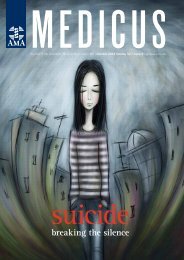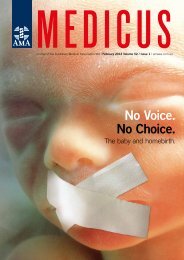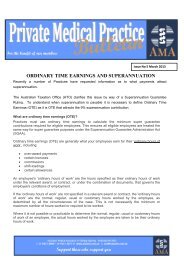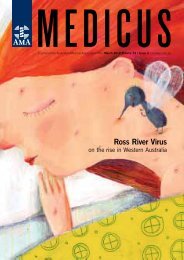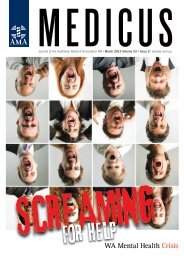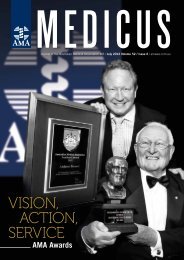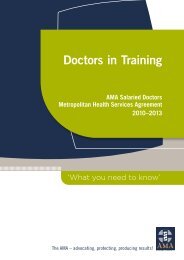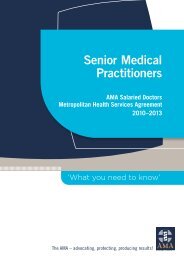twrama 1841_august_2.. - AMA WA
twrama 1841_august_2.. - AMA WA
twrama 1841_august_2.. - AMA WA
You also want an ePaper? Increase the reach of your titles
YUMPU automatically turns print PDFs into web optimized ePapers that Google loves.
OPINION<br />
Equity versus equality<br />
by Ghassan Zammar<br />
President, Medical Students’ Association of Notre Dame<br />
It was a shock to many students when the Victorian Health<br />
Department recently announced changes to the priority<br />
listing for medical graduates applying for internship positions<br />
for 2013. Unfortunately many did not see the humour when<br />
the Postgraduate Medical Council of Victoria released the<br />
information to final-year medical students on 8 June, the same<br />
day that the application process closed. For those interstate<br />
students who spent hours on their application, the timing of<br />
the announcement simply added fuel to the fire.<br />
Essentially, what these changes will mean is international<br />
students (who are Australian temporary residents) graduating<br />
from Victorian universities will be given greater priority over<br />
Australian permanent residents graduating from interstate<br />
medical schools. As with most states, Australian permanent<br />
residents graduating from Victorian medical schools will<br />
remain classified as priority one.<br />
The changes have generated mixed sentiments by the<br />
various medical students’ associations and within members<br />
of the AMSA council. Whether you agree or disagree, these<br />
current changes will have huge ramifications for final year<br />
medical students who have been studying in <strong>WA</strong>. This is more<br />
so evident at Notre Dame University, which is comprised of<br />
an interstate student population of about 40 per cent, many of<br />
whom have planned to return back home to begin their careers<br />
as doctors.<br />
There are many factors that come into<br />
play as to why the new three-tier<br />
system was developed. Many would<br />
see Victorian universities as the<br />
main instigators for the change,<br />
pressuring the State Government<br />
to increase job security for<br />
international students that graduate<br />
locally, and thereby increasing the<br />
demand for full fee-paying positions.<br />
This comes amid findings from<br />
the 2011 Higher Education Base<br />
Funding Review, which concluded<br />
that medical degrees in Australia<br />
were underfunded by up to $23,000<br />
per student, per annum. AMSA<br />
President James Churchill rightfully said: “Many medical<br />
schools are significantly reliant on international student<br />
revenue, the loss of which may have severe consequences for<br />
the quality of medical education in Australia.”<br />
Nevertheless, the relative impact that these changes will<br />
have on the demand from international students taking up<br />
highly-contested medical degrees is questionable. But for<br />
the first time, we may see domestic students missing out<br />
on internship spots that are filled by international<br />
students studying in Victoria.<br />
A primary factor<br />
suggested for the change<br />
in the internship selection<br />
process is to bring about<br />
a more “equitable”<br />
system. It is<br />
clear that many<br />
international<br />
students have<br />
been discriminated<br />
against for years<br />
by the different<br />
internship priority<br />
rankings across<br />
Australia, always<br />
placing them towards<br />
the bottom of the<br />
priority listings.<br />
Current AMSA figures<br />
suggest that over 90 per<br />
cent of the 370 expected<br />
internship shortages in 2013<br />
will be from international students<br />
looking for work. Having paid a small<br />
August MEDICUS August 37 MEDICUS 37




